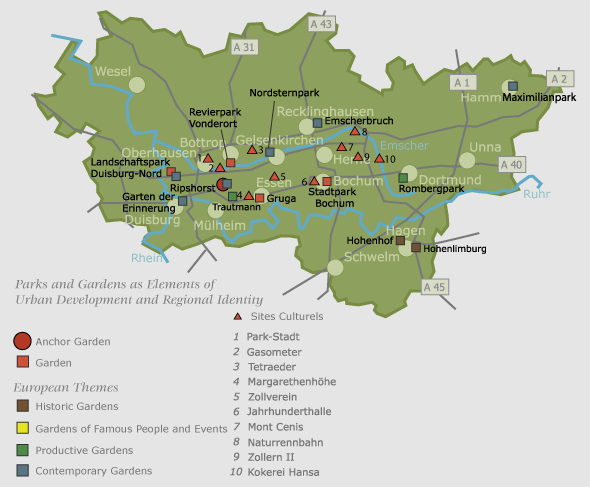 Parks and Gardens as Elements of Urban Development and Regional Identity
Parks and Gardens as Elements of Urban Development and Regional Identity
The park and garden landscape in the Ruhr is part of the region’s heritage of industrial culture. Like the impressive buildings of industrial architecture, parks and gardens reflect the history of settlement and the social and economic history of the Ruhr area.
The parks and gardens around castles, monasteries and manor houses were all conceived as geometrical Baroque complexes and are examples of the early history of the region. At the beginning of the 19th century, they were changed into landscape gardens in the “English style” in accordance with the type of design which was fashionable at the time and which reflected the spirit of education and liberalism. In the middle of the 19th century, advancing industrialisation changed the appearance of the landscape between the Ruhr and Emscher rivers. Representative gardens and parks were among the new “temples of industrial power”. The middle classes with possessions and education whose economic and social strength had grown also created representative parks which became public gardens in the Ruhr area. The rising industrial towns of the first highly-industrial phase also created their own public gardens.
Democratisation of urban green areas is today’s term to describe the Volksgarten (People’s Garden) movement of that time. The people’s garden was social (democratic) in that all social classes had the right to use it, it was also social (hygienic) for living conditions in that it balanced out dangerous air pollution.
The Bundesgartenschauen (Federal Garden Shows) of the 1950s caused new green areas to sprout from bombed-out cities, but they did not link up with the achievements of the democratic urban green areas. They did, however, contribute to the temporary revival of the citizens’ parks until the structure of the pluralist leisure society began to make itself felt in the 1960s with the creation of the “Revierpark”. This was a new kind of park developed in the Ruhr area with the specific aim of providing a space for relaxation and sport in a highly-industrialised landscape.
In 1984, a novelty was boldly attempted at the first Landesgartenschau (Regional Garden Show) in North Rhine-Westphalia, in Hamm. A slag heap in the Maximilian Park and an abandoned mining area were included in the planning of the park and “processed” artistically within the garden design as part of the industrial cultural landscape. This approach was used as a matter of course at the International Building Exhibition Emscher Park (IBA) and even became part of its programme.
The new parks which have been created since the 1990s are characterised by the way they take account of and emphasise the remains of the industrial past. At the same time, an attempt has been made to include the existing natural aesthetics of areas of waste ground and disused patches of industrial land in their design.
Today, the parks and gardens in the Ruhr area are more than just important open spaces for the population of the region. They are also “bearers of identity”, are of major significance for tourism as elements of the “Route of Industrial Heritage” and are not least a sign of a dynamic and forward-looking mood in regional development, which does not deny its periods of prosperity and crisis but uses these actively as unique assets.
This route is being created around the anchor garden of Haus Ripshorst in the Emscher Landscape Park in Oberhausen.